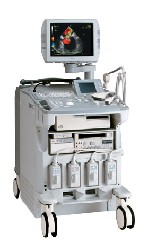Medical Ultrasound Imaging
Saturday, 27 April 2024
'Noise' Searchterm 'Noise' found in 15 articles 2 terms [ • ] - 13 definitions [• ] Result Pages : • Noise
An undesirable background interference or disturbance that affects image quality. The noise is commonly characterized by the standard deviation of signal intensity in the image of a uniform object (phantom) in the absence of artifacts. The measured noise may depend on the particular phantom used due to variable effects. Noisy images appear when the signal to noise ratio is too low. There are various noise sources in any electronic system, including Johnson noise, shot noise, thermal noise. See also Interference Artifact. • View NEWS results for 'Noise' (2). • •  From ALOKA Co., Ltd.;
From ALOKA Co., Ltd.;'A Platform for Pure Harmonic Detection Harmonic Echo™ technology constructs images using second harmonic components, which contain far less artifacts and noise than fundamental-frequency components. Pure Harmonic Detection is a technology to transmit distortion-free, fundamental-frequency ultrasound beams. And when the fundamental-frequency ultrasound beam is a pure sinusoidal wave, both the fundamental-frequency image and the Harmonic Echo™ image are much clearer with less noise. This technology is especially effective for obese patients and in a variety technically difficult scanning conditions.' •
Increasing the frequency of the transmitted power improves the image quality of ultrasound, but the improvement in resolution results in a decreased signal to noise ratio (SNR). Higher acoustic power levels can prevent the loss in SNR, but among other reasons, ultrasound regulations limit this to avoid heating or cavitation. Coded excitation increase the signal to noise ratio without the loss of resolution by using coded waveforms. Coded excitation allows transmitting a long wide-band pulse with more acoustic power and high penetration of the sound beam. •
Speckle noise affects the quality of the ultrasound images and can mask pathology. This artifact can be reduced by using a phase insensitive technique, or by canceling the undesirable linear-phase representation. More system samplings (needs more channels and memory) or a fuzzy logic algorithm can filter out the speckle noise.
Result Pages : |
Medical-Ultrasound-Imaging.com
former US-TIP.com
Member of SoftWays' Medical Imaging Group - MR-TIP • Radiology TIP • Medical-Ultrasound-Imaging
Copyright © 2008 - 2024 SoftWays. All rights reserved.
Terms of Use | Privacy Policy | Advertise With Us
former US-TIP.com
Member of SoftWays' Medical Imaging Group - MR-TIP • Radiology TIP • Medical-Ultrasound-Imaging
Copyright © 2008 - 2024 SoftWays. All rights reserved.
Terms of Use | Privacy Policy | Advertise With Us
[last update: 2023-11-06 01:42:00]




